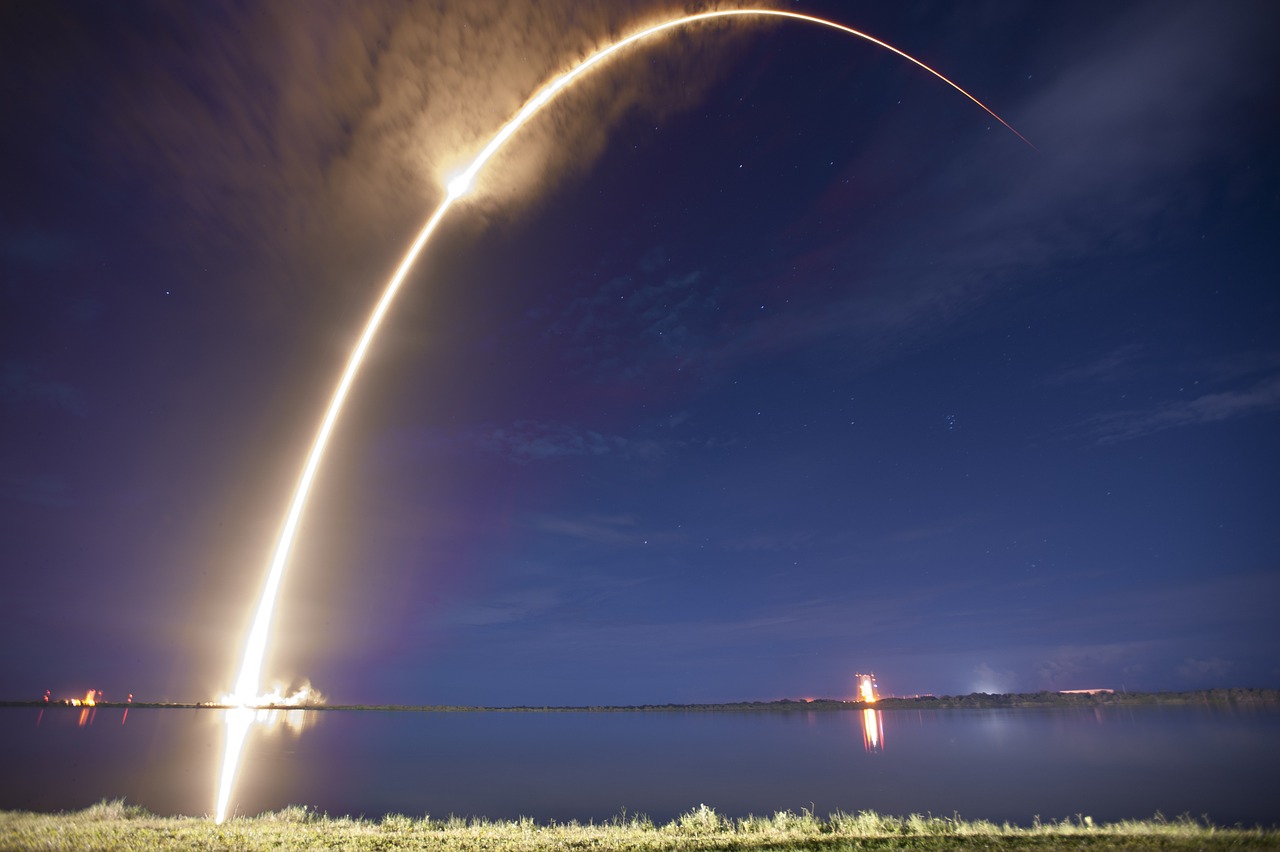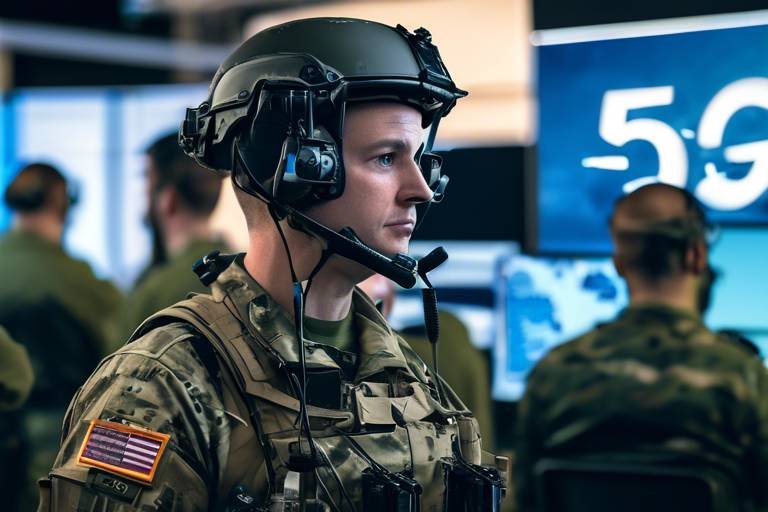AI-Driven Missile Defense Systems - Accuracy and Precision
The world of modern warfare is constantly evolving, and at the forefront of this evolution are AI-driven missile defense systems. These systems represent a significant leap forward in military technology, combining advanced algorithms and real-time data processing to enhance the accuracy and precision of missile interception. But what exactly does this mean for national security and military strategy? In this article, we will delve into the intricacies of AI technologies that are revolutionizing missile defense, examining their capabilities and the implications they hold for the future of defense operations.
Artificial intelligence is not just a buzzword; it's a game-changer in the realm of missile defense. By integrating AI, these systems are able to improve detection, tracking, and interception capabilities significantly. Imagine a scenario where a missile is launched; traditional systems may take seconds or even minutes to respond, but AI-driven systems can analyze the threat in real time, making split-second decisions that could save lives and protect assets. This rapid response is made possible through sophisticated algorithms that process vast amounts of data from various sensors, allowing for a comprehensive understanding of the battlefield.
At the heart of AI missile defense systems are several key technologies that work in harmony to provide unparalleled accuracy. These include machine learning, sensor fusion, and real-time data processing. Each of these technologies plays a crucial role in ensuring that missile defense systems are not only reactive but also predictive in nature. For instance, machine learning algorithms can analyze past engagements to refine their strategies, while sensor fusion combines data from multiple sources to create a unified threat assessment.
Machine learning is the backbone of AI missile defense systems. These algorithms allow systems to learn from previous engagements, adapting their response strategies over time. For instance, if a missile defense system encounters a new type of missile, it can analyze the engagement data to understand its trajectory and speed. This information is then used to enhance future intercept attempts. The ability to learn and evolve is akin to how humans learn from experiences, making these systems incredibly effective in dynamic combat environments.
To ensure high accuracy in predicting missile trajectories, rigorous data training and validation processes are essential. These processes involve feeding the system vast amounts of historical data regarding missile launches, trajectories, and outcomes. By validating this data, developers can fine-tune the algorithms, ensuring that they can accurately predict and respond to a variety of missile threats. This meticulous training process is akin to preparing an athlete for competition; the more data they have, the better they perform under pressure.
Another fascinating aspect of AI missile defense is the use of adaptive learning techniques. These techniques allow missile defense systems to adjust their parameters based on changing battlefield conditions. For instance, if a new enemy missile system is deployed, the AI can quickly analyze its characteristics and modify its interception strategies accordingly. This adaptability is crucial in modern warfare, where the landscape can change in the blink of an eye.
Sensor fusion technologies are vital for creating a comprehensive picture of the battlefield. By combining data from various sources—such as radar, infrared sensors, and satellite imagery—these systems can deliver a more accurate threat assessment. This integration not only enhances the precision of missile defense systems but also minimizes the risk of false alarms. Imagine trying to solve a puzzle with only a few pieces; sensor fusion provides the complete picture, enabling informed decision-making.
Despite the remarkable advancements in AI missile defense systems, there are still significant challenges to overcome. These include technological limitations, cybersecurity risks, and ethical considerations. As we dive deeper into these challenges, it's essential to recognize that while technology can enhance capabilities, it also introduces new vulnerabilities that must be addressed.
One of the most pressing concerns in AI missile defense is cybersecurity risks. As these systems become more interconnected, the potential for hacking and data manipulation increases. Securing these systems against cyber threats is paramount, as a successful attack could compromise national security. It's like locking your front door; you need to ensure that your defenses are robust enough to withstand any intrusion.
Furthermore, the use of AI in military applications raises important ethical implications. The decision-making processes in life-and-death scenarios can be fraught with moral dilemmas. Questions arise regarding accountability and the potential for unintended consequences. As we integrate AI into military strategies, it’s crucial to establish clear ethical guidelines that govern its use.
Looking ahead, the future of AI missile defense systems is filled with potential advancements. With ongoing research and development, we can expect to see significant improvements in technology and shifts in military strategy. The integration of AI with autonomous systems, for example, could enhance operational efficiency and responsiveness in combat situations.
Imagine AI missile defense systems working seamlessly alongside autonomous drones and robots. This integration could lead to a new era of warfare where human operators are supported by machines that can execute complex tasks with precision. The potential for increased operational efficiency is immense, and as these systems evolve, they could redefine how military operations are conducted.
Lastly, the potential for global defense collaborations in developing AI missile defense technologies is an exciting prospect. As nations face common threats, working together to enhance security and stability through shared technology could lead to a more secure world. International partnerships can foster innovation and ensure that advancements in missile defense benefit all parties involved.
- What are AI-driven missile defense systems? - These are advanced military systems that utilize artificial intelligence to improve the detection, tracking, and interception of missiles.
- How does machine learning enhance missile defense? - Machine learning algorithms allow missile defense systems to learn from past engagements, improving their response strategies over time.
- What are the cybersecurity risks associated with AI missile defense? - The interconnected nature of these systems makes them vulnerable to hacking and data manipulation, which could compromise national security.
- What ethical considerations arise from using AI in military applications? - The deployment of AI in military contexts raises questions about accountability and the potential for unintended consequences in life-and-death scenarios.

Understanding AI in Missile Defense
Artificial Intelligence (AI) is revolutionizing the way we approach missile defense systems, transforming them into highly sophisticated tools capable of responding to threats with remarkable accuracy and speed. At its core, AI enhances the ability of these systems to detect, track, and intercept incoming missiles, effectively turning what was once a purely mechanical process into a dynamic, intelligent operation. Imagine having a defense system that not only reacts to threats but learns from every engagement, adapting its strategies in real-time. This is the power of AI in missile defense.
One of the most significant advancements in missile defense technology is the integration of AI algorithms that process vast amounts of data from various sensors. These sensors collect information from radar, satellites, and other sources, creating a multi-dimensional view of the battlefield. By utilizing machine learning, these systems can analyze this data to identify patterns and predict missile trajectories with high precision. The ability to process and interpret data in real-time means that decisions can be made faster than ever before, significantly reducing the response time to incoming threats.
Furthermore, AI systems are designed to improve their performance over time. Through a process known as adaptive learning, missile defense systems can adjust their parameters based on previous engagements and the ever-changing dynamics of warfare. This means that what worked in one scenario can be modified for another, allowing for a more flexible and responsive defense strategy. It's akin to a seasoned chess player who learns from every match, continuously refining their tactics to outsmart opponents.
However, the integration of AI into missile defense is not without its complexities. The systems must be able to differentiate between genuine threats and false alarms, a task that becomes increasingly challenging as the number of potential threats rises. This is where the concept of sensor fusion comes into play. By combining data from multiple sources, AI can create a comprehensive picture of the battlefield, enhancing threat assessment and response capabilities. For instance, if multiple sensors detect an object, AI algorithms can analyze the data to determine whether it is a missile, a drone, or even a bird, ensuring that the defense system only engages when absolutely necessary.
In summary, the integration of AI into missile defense systems represents a significant leap forward in military technology. With enhanced detection, tracking, and interception capabilities, these systems are becoming more accurate and precise than ever before. The ability to learn and adapt in real-time not only improves operational effectiveness but also reshapes military strategy and national security considerations. As we move forward, the implications of these advancements will undoubtedly influence global defense policies and international relations.
- How does AI improve missile defense systems? AI enhances missile defense by enabling real-time data processing, adaptive learning, and sensor fusion, leading to faster and more accurate threat detection and response.
- What are the key technologies involved in AI missile defense? Key technologies include machine learning algorithms, sensor fusion technologies, and advanced data processing techniques that work together to create a comprehensive defense system.
- What challenges do AI missile defense systems face? Challenges include cybersecurity risks, the need for high accuracy in threat assessment, and ethical implications regarding decision-making in military contexts.
- What is the future of AI in missile defense? The future may see further integration with autonomous systems and increased global collaborations to enhance security and stability in defense technologies.

Key Technologies Behind AI Missile Defense
In the realm of modern warfare, achieving superior missile defense capabilities is paramount. Artificial Intelligence (AI) has emerged as a game-changer, unlocking a suite of technologies that significantly enhance the effectiveness of missile defense systems. At the heart of these advancements are several key technologies that work in harmony to improve detection, tracking, and interception. Let's delve into the intricate workings of these technologies and see how they contribute to the overall precision and accuracy of missile defense.
One of the cornerstones of AI missile defense is the utilization of machine learning algorithms. These algorithms allow defense systems to analyze vast amounts of data from previous missile engagements, learning from each encounter to refine their response strategies. Imagine a system that evolves over time, much like a student who learns from past tests to ace future ones. This capability ensures that the missile defense systems are not static; instead, they adapt and improve continuously.
To harness the power of machine learning, data training and validation are crucial. This process involves feeding the algorithms with historical data, which includes various missile trajectories, environmental conditions, and engagement outcomes. The goal is to create a robust model that can predict future missile paths with high accuracy. The training phase is akin to teaching a child how to recognize different shapes and colors; the more examples they see, the better they become at identifying them. Validation ensures that the model can generalize its learning to new, unseen scenarios, making it reliable in real-world applications.
Adaptive learning techniques further enhance missile defense systems by enabling them to adjust their parameters based on real-time battlefield conditions. For instance, if a new missile type is detected, the system can quickly recalibrate its algorithms to account for the different characteristics of the threat. This adaptability is crucial, as the battlefield is dynamic and often unpredictable. It’s like a dancer who can change their routine mid-performance to respond to the music's tempo; the ability to adapt can mean the difference between success and failure in intercepting threats.
Another pivotal technology in AI missile defense is sensor fusion. This process involves integrating data from multiple sensors to create a comprehensive situational awareness picture. By combining inputs from radar, infrared sensors, and other detection systems, missile defense platforms can achieve a level of accuracy that single-source systems simply cannot match. Think of it as assembling a jigsaw puzzle; each piece of data contributes to the overall image, allowing for a clear understanding of the threat landscape. The result is a more accurate threat assessment, enabling quicker and more effective responses to incoming missiles.
| Technology | Description |
|---|---|
| Machine Learning Algorithms | Algorithms that learn from past engagements to improve response strategies. |
| Data Training and Validation | Processes that ensure the accuracy of predictions by training on historical data. |
| Adaptive Learning Techniques | Techniques that allow systems to adjust to new threats in real-time. |
| Sensor Fusion Technologies | Integration of data from multiple sources for enhanced situational awareness. |
In conclusion, the integration of these key technologies into AI missile defense systems represents a significant leap forward in military capabilities. By leveraging machine learning, adaptive learning, and sensor fusion, these systems are not only improving their accuracy and precision but are also redefining the landscape of national security. As threats evolve, so too must our defenses, and AI is paving the way for a more secure future.
- What is AI missile defense? AI missile defense refers to the use of artificial intelligence technologies to enhance the detection, tracking, and interception of missiles.
- How do machine learning algorithms improve missile defense? Machine learning algorithms analyze past missile engagements to refine response strategies, allowing systems to adapt and improve over time.
- What role does sensor fusion play in missile defense? Sensor fusion combines data from various sensors to provide a comprehensive understanding of threats, resulting in more accurate assessments and quicker responses.
- What are the challenges faced by AI missile defense systems? Challenges include technological limitations, cybersecurity risks, and ethical implications regarding decision-making in military applications.

Machine Learning Algorithms
When we talk about in the context of missile defense systems, we're diving into a realm where technology meets military strategy in fascinating ways. These algorithms are the brains behind the operation, allowing systems to not just react but to learn and adapt over time. Imagine a player in a strategic game who becomes better with every match played—this is essentially what machine learning does for missile defense systems. By analyzing previous engagements, these systems can refine their tactics, improving their chances of successfully intercepting incoming threats.
At the core of these algorithms is the ability to process vast amounts of data. Think about it: a missile defense system must evaluate countless variables in real-time, such as speed, trajectory, and potential impact points of incoming missiles. This is where data training comes into play. The algorithms are trained using historical data, which includes successful interceptions and failures. This training phase is crucial because it sets the foundation for the system's predictive capabilities. The more data the system processes, the more accurate its predictions become.
Furthermore, the validation of this data is equally important. It ensures that the machine learning models are not just good at memorizing past events but can generalize their learning to new situations. This is akin to a student who not only memorizes facts but understands concepts well enough to tackle different problems. In missile defense, this understanding translates to improved accuracy when predicting missile trajectories, ultimately leading to higher success rates in intercepting threats.
Another fascinating aspect of machine learning in missile defense is the use of adaptive learning techniques. These techniques allow the systems to modify their algorithms based on real-time feedback from the battlefield. For instance, if a new type of missile is detected that behaves differently from previous models, the system can adjust its parameters to optimize its response. This adaptability is like a seasoned athlete who can change their strategy mid-game based on the opponent's moves. The ability to learn and adapt in real-time is a game-changer in missile defense, making these systems not just reactive but proactively intelligent.
In summary, machine learning algorithms are revolutionizing missile defense systems by enabling them to learn from past experiences, validate their predictive capabilities, and adapt to new challenges. As these technologies continue to evolve, we can expect even greater advancements in accuracy and precision, fundamentally changing how nations approach their defense strategies.
- What are machine learning algorithms? Machine learning algorithms are computational methods that allow systems to learn from data and improve their performance over time without being explicitly programmed for each specific task.
- How do these algorithms improve missile defense systems? They enhance missile defense systems by enabling them to analyze historical data, predict missile trajectories, and adapt to new threats in real-time, leading to higher interception success rates.
- What is data training in the context of machine learning? Data training involves feeding historical data into the machine learning models to help them learn patterns and make accurate predictions about future events.
- What are adaptive learning techniques? Adaptive learning techniques allow missile defense systems to modify their algorithms based on real-time feedback, improving their responses to new and evolving threats.

Data Training and Validation
When it comes to AI-driven missile defense systems, the importance of cannot be overstated. These systems rely heavily on vast amounts of data to learn and adapt, making the quality of this data paramount. Imagine trying to teach a child how to ride a bike without showing them how to balance; similarly, missile defense systems need accurate and comprehensive data to effectively predict and intercept incoming threats.
Data training involves feeding the AI algorithms with historical data from past missile engagements, which helps them recognize patterns and make informed decisions in real-time. This process is akin to a chef perfecting their recipe by tweaking ingredients based on previous meals. The more data the system ingests, the better it becomes at distinguishing between genuine threats and false alarms. However, it’s not just about quantity; the quality of the data is crucial. If the data is flawed, the system's performance can be compromised, leading to potentially disastrous consequences.
Validation, on the other hand, ensures that the model's predictions are accurate and reliable. This step is like a rigorous exam for the AI, testing its ability to apply what it has learned in simulated environments. Engineers and data scientists use various techniques to validate the model, often employing a separate dataset that the AI hasn't encountered before. This way, they can assess how well the system can generalize its learning to new, unseen scenarios. A well-validated model can significantly enhance the accuracy of missile interception, providing military strategists with a reliable tool for national defense.
To illustrate the process further, consider the following table that outlines the key steps involved in data training and validation:
| Step | Description |
|---|---|
| Data Collection | Gathering historical missile engagement data from various sources. |
| Data Preprocessing | Cleaning and organizing data to remove noise and irrelevant information. |
| Model Training | Feeding the processed data into the AI algorithms for learning. |
| Model Validation | Testing the model with a separate dataset to ensure accuracy. |
| Performance Evaluation | Assessing the model's predictions and making necessary adjustments. |
In summary, data training and validation are critical components that ensure AI missile defense systems operate at peak efficiency. By continuously refining their learning processes, these systems can adapt to evolving threats, ultimately enhancing national security. As we look to the future, the ongoing improvement of these processes will be essential for maintaining an edge in military technology.
- What is the role of data in AI missile defense systems? Data is essential for training AI algorithms to recognize and respond to missile threats accurately.
- How is data validated in missile defense systems? Data is validated by testing the AI model with separate datasets to ensure its predictions are reliable.
- Why is data quality important? High-quality data improves the accuracy of predictions and helps prevent false alarms in missile defense.
- What happens if the AI model is not well-validated? A poorly validated model could lead to incorrect threat assessments, potentially compromising national security.

Adaptive Learning Techniques
Adaptive learning techniques are a game-changer in the realm of AI-driven missile defense systems. Imagine a system that doesn't just react to threats but learns from every engagement, becoming smarter with each encounter. This capability is akin to a seasoned chess player who, after countless games, begins to anticipate their opponent's moves. In missile defense, this means that the systems can adjust their strategies based on real-time data and previous experiences, significantly enhancing their effectiveness.
At the core of adaptive learning is the ability to analyze vast amounts of data quickly. Missile defense systems utilize advanced algorithms to process information from various sensors and sources, allowing them to identify patterns and trends. For example, if a particular type of missile is detected frequently in a specific region, the system can adapt its response protocols accordingly. This proactive approach not only improves accuracy but also increases the chances of successful interceptions.
Moreover, adaptive learning techniques incorporate feedback loops. These loops allow the system to evaluate its performance continuously and make necessary adjustments. Think of it as a self-improving cycle: the system detects a threat, responds, analyzes the outcome, and then refines its approach. This iterative process ensures that the missile defense system remains at the cutting edge, capable of countering evolving threats in real-time.
One of the significant advantages of these techniques is their ability to operate under changing battlefield conditions. In the chaos of modern warfare, where variables shift rapidly, an adaptive system can reconfigure its parameters to maintain optimal performance. For instance, if enemy tactics change or new missile technologies emerge, the system can learn from these developments and adapt its strategies without requiring extensive reprogramming.
However, implementing adaptive learning is not without its challenges. The complexity of the algorithms and the need for high-quality data can pose significant hurdles. To ensure that the adaptive learning process is effective, missile defense systems must be trained on diverse datasets that accurately reflect potential threats. This training process is crucial for achieving the desired level of accuracy and reliability, making it a critical focus for engineers and developers in the field.
In summary, adaptive learning techniques are revolutionizing missile defense systems, allowing them to become more responsive and effective in the face of ever-evolving threats. As these systems continue to learn and adapt, they not only enhance national security but also pave the way for a new era of military strategy, where technology and human ingenuity work hand in hand to protect nations from potential dangers.
- What are adaptive learning techniques?
Adaptive learning techniques refer to methods that allow systems to learn from experiences and adjust their responses based on real-time data and previous engagements. - How do adaptive learning techniques enhance missile defense?
These techniques enable missile defense systems to improve their accuracy and effectiveness by analyzing past engagements and adjusting strategies accordingly. - What challenges are associated with implementing adaptive learning in missile defense?
Challenges include the complexity of algorithms, the need for high-quality data, and ensuring the system can adapt to rapidly changing battlefield conditions. - Can adaptive learning techniques be used in other military applications?
Yes, adaptive learning techniques have the potential to be applied in various military applications beyond missile defense, enhancing overall operational efficiency.

Sensor Fusion Technologies
In the realm of missile defense, play a pivotal role in enhancing the accuracy and effectiveness of defense systems. Imagine trying to piece together a jigsaw puzzle, but instead of just using one picture, you have multiple images that, when combined, give you a clearer and more comprehensive view of what you’re trying to solve. That’s essentially what sensor fusion does—it aggregates data from various sensors to create a unified picture of the battlefield.
These technologies leverage inputs from a variety of sources, including radar, infrared sensors, and satellite data, to ensure that missile defense systems have the most accurate and timely information possible. By integrating these diverse data streams, systems can better identify, track, and classify potential threats. For instance, if a missile is launched, radar might pick up its trajectory, while infrared sensors can detect its heat signature. When this information is fused, the defense system can make quicker and more informed decisions on how to respond.
One of the most significant advantages of sensor fusion is its ability to reduce false positives. In military operations, the cost of misidentifying a threat can be catastrophic. With advanced algorithms and machine learning techniques, sensor fusion technologies can filter out irrelevant data and focus on what truly matters. This ensures that the missile defense system is not only reacting swiftly but also accurately, which is crucial in high-stakes scenarios.
Moreover, the integration of sensor fusion technologies allows for real-time decision-making. In the heat of battle, every second counts. By synthesizing data in real time, missile defense systems can adapt to changing conditions and respond to new threats as they emerge. This capability is akin to a chess player anticipating their opponent's moves several steps ahead, ensuring that they are always one move away from countering any attack.
To illustrate the impact of sensor fusion technologies, consider the following table that outlines the different types of sensors commonly used in missile defense and their respective contributions:
| Type of Sensor | Function | Contribution to Missile Defense |
|---|---|---|
| Radar | Detects and tracks objects | Provides initial detection and trajectory information |
| Infrared Sensors | Detects heat signatures | Identifies and confirms the presence of missiles |
| Satellite Imagery | Offers a broad view of the battlefield | Enhances situational awareness and threat assessment |
| Electro-Optical Sensors | Captures visual data | Provides confirmation of targets and assists in tracking |
As we look towards the future, the evolution of sensor fusion technologies is expected to continue at a rapid pace. With advancements in artificial intelligence and machine learning, we can anticipate even greater levels of integration and efficiency. This will not only bolster the capabilities of missile defense systems but also enhance overall military strategy by providing a more nuanced understanding of the battlefield.
- What is sensor fusion in missile defense? Sensor fusion refers to the integration of data from multiple sensors to create a comprehensive understanding of potential threats, improving accuracy and response times.
- How does sensor fusion improve missile defense? By combining data from various sources, sensor fusion reduces false positives and enhances real-time decision-making, allowing for more effective threat identification and response.
- What types of sensors are used in missile defense systems? Common sensors include radar, infrared sensors, satellite imagery, and electro-optical sensors, each contributing unique data to the overall threat assessment.

Challenges in AI Missile Defense
As the world becomes increasingly reliant on technology, the integration of artificial intelligence into missile defense systems presents both exciting opportunities and significant challenges. While these systems promise enhanced accuracy and precision, they are not without their hurdles. One of the most pressing issues is the technological limitations that currently exist. Despite advancements, AI systems can struggle with real-time decision-making in complex environments. Imagine a high-stakes race where the driver must react to unexpected obstacles; the same applies to AI systems that must rapidly process vast amounts of data and make split-second decisions.
Additionally, the potential for cyber threats looms large. As AI missile defense systems become more interconnected, they also become more vulnerable to hacking and data manipulation. A cyber attack on these systems could have catastrophic consequences, akin to a thief breaking into a bank vault; the implications of such breaches could compromise national security. To mitigate these risks, robust cybersecurity measures must be implemented, ensuring that the integrity of the systems remains intact.
Moreover, the ethical implications of using AI in military applications cannot be overlooked. The prospect of machines making life-and-death decisions raises profound questions. Who is responsible when an AI system makes a mistake? Is it the programmer, the military, or the machine itself? These ethical dilemmas create a complex landscape that requires careful consideration. The military must grapple with the balance between leveraging AI for efficiency and maintaining human oversight in critical decision-making processes.
Furthermore, there is a challenge in ensuring data quality. AI systems rely on vast datasets to learn and improve, but if the data is flawed or biased, the outcomes can be detrimental. Think of it like a chef who uses spoiled ingredients; the final dish will not only be unappetizing but could also pose health risks. Therefore, rigorous data validation processes are essential to maintain the accuracy of AI predictions.
In summary, while AI-driven missile defense systems hold great promise for enhancing national security, they come with a set of challenges that must be addressed. From technological limitations and cybersecurity risks to ethical considerations and data quality issues, the road ahead is complex. As we advance further into this AI-driven era, it is vital to navigate these challenges thoughtfully to harness the full potential of these systems while safeguarding against their inherent risks.
- What are the main challenges in AI missile defense systems?
The main challenges include technological limitations, cybersecurity risks, ethical implications, and ensuring data quality.
- How do cybersecurity risks affect AI missile defense?
Cybersecurity risks can lead to hacking and data manipulation, potentially compromising the effectiveness and safety of missile defense systems.
- Why are ethical implications important in AI military applications?
Ethical implications are crucial because they raise questions about accountability and decision-making in life-and-death scenarios.
- What is the significance of data quality in AI systems?
Data quality is significant because flawed or biased data can lead to inaccurate predictions and responses, undermining the effectiveness of the system.

Cybersecurity Risks
In an era where technology drives military advancements, have emerged as a paramount concern, especially for AI-driven missile defense systems. These systems, while revolutionary, are not immune to the vulnerabilities that come with digital integration. Imagine a fortress designed to protect a kingdom, only to discover that its gates can be breached by a clever adversary wielding a keyboard instead of a sword. This analogy perfectly encapsulates the precarious balance between innovation and security in modern defense mechanisms.
One of the most pressing issues is the potential for hacking. Cybercriminals and state-sponsored actors alike are constantly probing for weaknesses in these sophisticated systems. A successful breach could lead to unauthorized access, allowing adversaries to manipulate data or even take control of missile defense operations. The consequences of such actions could be catastrophic, as they not only jeopardize national security but also undermine public confidence in military capabilities.
Moreover, the integration of AI complicates matters further. AI systems rely on vast amounts of data to function effectively, making them attractive targets for cyberattacks. If an adversary can corrupt the data used for training these AI models, the implications could be dire. For instance, if a missile defense system is fed inaccurate information about an incoming threat, it may fail to respond appropriately, leading to disastrous outcomes. In this context, the importance of data integrity cannot be overstated.
To illustrate the potential risks, consider the following scenarios:
- Data Manipulation: An attacker alters the trajectory data of incoming missiles, causing the defense system to miscalculate its response.
- System Takeover: A successful cyber intrusion allows an adversary to disable or reprogram defense systems, rendering them useless during a critical moment.
- Insider Threats: Even trusted personnel could be compromised, either through coercion or manipulation, leading to intentional sabotage.
Addressing these cybersecurity risks requires a multi-faceted approach. Defense organizations must invest in robust security protocols, continuous monitoring, and rapid response capabilities to thwart potential attacks. Regular updates and patches for software vulnerabilities are essential, as is the implementation of advanced encryption techniques to safeguard sensitive data. Furthermore, fostering a culture of cybersecurity awareness among personnel can significantly reduce the risk of insider threats and human error.
As we look to the future, it’s clear that cybersecurity will remain a critical component of AI missile defense systems. The stakes are incredibly high, and the need for vigilance is paramount. Just as a castle requires constant maintenance to withstand siege, so too must our defense systems evolve to counteract the ever-changing landscape of cyber threats.
- What are the main cybersecurity threats to AI missile defense systems? The main threats include hacking, data manipulation, and insider threats that can compromise system integrity and effectiveness.
- How can military organizations protect against these cyber threats? Organizations can enhance their cybersecurity posture by implementing robust security protocols, conducting regular system updates, and fostering a culture of cybersecurity awareness among personnel.
- What role does data integrity play in missile defense systems? Data integrity is crucial, as inaccurate or manipulated data can lead to incorrect threat assessments and potentially catastrophic failures in defense responses.

Ethical Implications
The integration of artificial intelligence into missile defense systems raises significant ethical questions that society must grapple with. When we think about AI making decisions that can lead to life or death outcomes, it evokes a sense of unease. Is it truly acceptable for machines to determine the fate of human lives? This dilemma is not just a technical issue; it strikes at the very core of our moral frameworks and societal values.
One of the primary ethical concerns involves the autonomy of decision-making. As AI systems become more sophisticated, there is a risk that they might operate without sufficient human oversight. For instance, if an AI system identifies a potential missile threat, it might autonomously engage without human intervention. This leads to the unsettling question: who is responsible if the AI makes an erroneous decision? The implications of such actions could be catastrophic, leading to unintended escalations of conflict and loss of innocent lives.
Moreover, the transparency of AI algorithms is another critical ethical issue. Many AI systems operate as "black boxes," where the decision-making process is not easily understood, even by their creators. This lack of transparency can lead to mistrust among the public and military personnel alike. If a missile defense system mistakenly identifies a commercial airliner as a threat, the inability to trace the decision-making process back to a clear rationale can exacerbate the consequences of the mistake.
In addition, we must consider the potential for bias in AI systems. If the data used to train these systems is skewed or unrepresentative, the resulting AI may make biased decisions. For example, if an AI system is trained predominantly on data from one region, it may not accurately assess threats in another area, leading to disproportionate responses. This brings forth the critical need for diverse data and rigorous testing to ensure fairness in AI operations.
To illustrate these ethical concerns, let's look at a hypothetical scenario:
| Scenario | Ethical Concern | Potential Consequence |
|---|---|---|
| AI autonomously engages a target | Lack of human oversight | Unintended escalation of conflict |
| AI misidentifies a civilian aircraft | Transparency issues | Loss of innocent lives |
| AI trained on biased data | Data representation | Disproportionate military response |
As we move forward, it is crucial to establish robust frameworks and guidelines that govern the use of AI in military applications. This includes creating policies that ensure human oversight, transparency in AI algorithms, and a commitment to ethical standards that prioritize human life. Engaging a broad spectrum of stakeholders, including ethicists, technologists, and military leaders, will be essential in shaping a responsible approach to AI integration in missile defense systems.
- What are the main ethical concerns regarding AI in missile defense? The main concerns include autonomy of decision-making, transparency of algorithms, and potential biases in AI systems.
- How can we ensure that AI systems are making ethical decisions? Establishing robust oversight, transparency, and diverse data training can help ensure ethical decision-making in AI systems.
- What happens if an AI system makes a mistake? Mistakes can lead to catastrophic consequences, including loss of life and escalation of conflict, highlighting the need for human oversight.

Future Trends in AI Missile Defense
As we gaze into the crystal ball of military technology, one thing is clear: the future of AI missile defense systems is poised for remarkable transformation. With advancements in artificial intelligence, we can expect a paradigm shift that not only enhances the effectiveness of missile defense but also reshapes military strategy on a global scale. Imagine a world where defense systems are not just reactive but also proactive, capable of predicting threats before they even materialize. This is the exciting frontier we are heading toward.
One of the most significant trends is the integration of AI with autonomous systems. Picture drones and robotic platforms working in tandem with AI missile defense systems, creating a layered defense mechanism that is both agile and responsive. These autonomous systems can gather real-time intelligence, analyze data, and even make decisions without human intervention. This synergy will enhance operational efficiency, allowing military forces to respond to threats with unprecedented speed and accuracy. The battlefield of the future will resemble a chess game, where every piece is interconnected, and each move is calculated with precision.
Moreover, the potential for global defense collaborations is on the rise. Countries are increasingly recognizing that threats do not adhere to borders, leading to partnerships that pool resources and expertise in developing AI missile defense technologies. Imagine a scenario where nations share data and collaborate on research, creating a unified front against common adversaries. This not only strengthens individual nations' defense capabilities but also fosters international stability. By working together, countries can create a more secure world, where the collective intelligence of AI systems enhances national security.
However, as we embrace these advancements, we must also navigate the complexities they introduce. The integration of AI in military applications raises important questions about ethical considerations. Who is responsible when an AI system makes a decision that leads to unintended consequences? As we develop these technologies, it is crucial to establish frameworks that ensure accountability and transparency. The future of AI missile defense must not only focus on technological prowess but also on the moral implications of its use.
In conclusion, the future trends in AI missile defense are not just about technological advancements; they are about redefining how we think about warfare and security. As AI continues to evolve, so too will our strategies for defense, making it imperative for military leaders and policymakers to stay ahead of the curve. The next decade promises to be a thrilling ride, where innovation meets strategy, and the stakes have never been higher.
- What are AI missile defense systems? AI missile defense systems leverage artificial intelligence technologies to enhance detection, tracking, and interception capabilities against incoming missile threats.
- How will autonomous systems change missile defense? Autonomous systems will work alongside AI missile defense, improving responsiveness and operational efficiency by gathering real-time data and making decisions rapidly.
- What are the ethical implications of AI in military applications? The use of AI in military applications raises questions about accountability and decision-making, particularly in life-and-death scenarios.
- Can global collaboration enhance missile defense? Yes, global collaborations can pool resources and expertise, creating a unified approach to missile defense that enhances security for all nations involved.

Integration with Autonomous Systems
As we stand on the brink of a new era in military technology, the integration of AI missile defense systems with autonomous systems is poised to revolutionize how nations defend their airspace. Imagine a battlefield where drones, robots, and AI-driven missile defense units work together seamlessly, sharing information and making split-second decisions to neutralize threats. This isn’t just a sci-fi fantasy; it’s becoming a reality. The synergy between these technologies enhances operational efficiency, responsiveness, and ultimately, national security.
One of the most exciting aspects of this integration is the ability of autonomous systems to collect and analyze data in real-time. For example, autonomous drones can patrol vast areas, identifying potential threats before they reach critical zones. They can relay this information back to missile defense systems, which can then calculate the best response strategy. This kind of collaboration not only improves accuracy but also reduces the time it takes to respond to incoming threats, which can be the difference between success and failure in a military operation.
Moreover, the use of autonomous systems allows for a decentralized approach to missile defense. Instead of relying solely on a few centralized command units, the integration of autonomous drones and ground units creates a network of defense capabilities. This means that even if one unit is compromised, others can continue to operate effectively. The resilience and adaptability of such a system make it a formidable opponent against adversaries.
However, integrating these systems is not without its challenges. There are concerns about communication protocols between different types of autonomous systems. Ensuring that data is transmitted securely and accurately is critical. Additionally, the potential for malfunction or miscommunication could lead to disastrous outcomes, such as friendly fire incidents or failure to intercept a genuine threat. As we explore these technologies, it’s essential to prioritize robust testing and validation processes to mitigate these risks.
Furthermore, the ethical implications of using autonomous systems in military applications cannot be ignored. Questions arise about the extent to which machines should be allowed to make life-and-death decisions. Striking a balance between leveraging advanced technology and maintaining human oversight is crucial. Military leaders and policymakers must engage in ongoing discussions to establish clear guidelines and frameworks that govern the use of AI in combat scenarios.
In conclusion, the integration of AI missile defense systems with autonomous systems represents a significant leap forward in military strategy. It offers enhanced capabilities and resilience, but it also requires a careful approach to address the inherent challenges and ethical considerations. As we move forward, the focus must remain on developing technologies that not only protect nations but also uphold the values of humanity.
- What are autonomous systems in military applications?
Autonomous systems are machines or devices that can operate independently without human intervention, often utilizing AI to make decisions based on real-time data. - How does AI improve missile defense accuracy?
AI enhances missile defense accuracy by using advanced algorithms to analyze data quickly, predict missile trajectories, and optimize interception strategies. - What are the risks of integrating AI with military systems?
Risks include cybersecurity threats, potential malfunctions, ethical dilemmas regarding decision-making, and the possibility of unintended consequences in combat scenarios. - Can autonomous systems operate without human oversight?
While autonomous systems can perform tasks independently, human oversight is crucial in military applications to ensure ethical decision-making and accountability.

Global Defense Collaborations
In today's rapidly evolving security landscape, have become more critical than ever. Nations are recognizing that the threats they face are not confined by borders; they are often transnational and require a unified response. This realization has led to a surge in partnerships aimed at enhancing missile defense capabilities through shared technology, intelligence, and resources. Imagine a world where countries come together like a well-oiled machine, each contributing its unique strengths to create a formidable defense against potential missile attacks.
One of the most significant aspects of these collaborations is the sharing of cutting-edge technologies. Countries like the United States, Israel, and Japan have been at the forefront of developing advanced missile defense systems, and through collaborations, they can share insights and innovations. For instance, the Arrow defense system, developed by Israel, has seen enhancements through joint efforts with the U.S., showcasing how shared knowledge can lead to improved defense mechanisms. These partnerships not only bolster national security but also foster technological advancements that benefit all parties involved.
Furthermore, these collaborations often include joint military exercises that simulate various attack scenarios. Such exercises are instrumental in honing the skills of military personnel and testing the effectiveness of missile defense systems in real-time. By working together, nations can identify weaknesses in their strategies and make necessary adjustments. It's akin to a sports team practicing together; the more they play, the better they understand each other's strengths and weaknesses, ultimately leading to a more cohesive unit.
However, it's not just about technology and exercises; intelligence sharing plays a crucial role as well. Countries involved in defense collaborations often exchange crucial data regarding missile threats, enabling quicker and more informed decision-making. This intelligence can come from various sources, including satellite imagery, radar data, and even human intelligence. The ability to pool resources and information means that nations can respond to threats more effectively, enhancing the overall security of not just one nation, but the collective group.
In addition to military and technological aspects, also pave the way for diplomatic relationships. Countries that work together on defense initiatives often find themselves in a stronger position to negotiate other international issues. The bonds formed through these collaborations can lead to enhanced trust and cooperation in other areas, such as trade and environmental policies. This interconnectedness is vital in a world where geopolitical tensions can escalate quickly.
To further illustrate the impact of global defense collaborations, consider the following table that outlines some key partnerships and their contributions to missile defense:
| Partnership | Key Contributions |
|---|---|
| U.S. and Israel | Development of Arrow defense system; joint military exercises |
| U.S. and Japan | Integration of Aegis system; sharing of radar technology |
| NATO Allies | Collective defense strategies; intelligence sharing |
As we look to the future, it's clear that the landscape of missile defense will continue to evolve. The need for countries to collaborate on defense initiatives is not just a trend; it’s a necessity. With emerging threats and the increasing complexity of warfare, will play a pivotal role in ensuring national security and maintaining peace. By working together, nations can build a robust defense framework that is adaptable, resilient, and capable of responding to the challenges of tomorrow.
- What are global defense collaborations?
Global defense collaborations refer to partnerships between countries aimed at enhancing military capabilities, particularly in missile defense systems, through shared technology, intelligence, and resources. - Why are these collaborations important?
They are crucial for addressing transnational threats, improving response times to missile attacks, and fostering stronger diplomatic relationships among nations. - How do countries share technology in these collaborations?
Countries often engage in joint research and development projects, participate in military exercises, and exchange critical intelligence and data to enhance their missile defense systems. - What role does intelligence sharing play in missile defense?
Intelligence sharing allows countries to access vital information about potential threats, enabling quicker and more informed decision-making during crises.
Frequently Asked Questions
- What is the role of AI in missile defense systems?
AI plays a crucial role in enhancing missile defense systems by improving their detection, tracking, and interception capabilities. It allows these systems to process vast amounts of data quickly, enabling timely responses to threats.
- How do machine learning algorithms improve missile defense?
Machine learning algorithms enable missile defense systems to learn from past engagements. This continuous learning process helps these systems adapt their strategies, making them more effective over time in predicting and countering missile threats.
- What are the challenges faced by AI missile defense systems?
AI missile defense systems face several challenges, including technological limitations, cybersecurity risks, and ethical considerations. Addressing these challenges is essential for ensuring their reliability and effectiveness in real-world scenarios.
- How does sensor fusion enhance missile defense?
Sensor fusion combines data from multiple sources, creating a comprehensive view of the battlefield. This integration allows for more accurate threat assessments, enabling quicker and more effective responses to incoming missiles.
- What are the ethical implications of using AI in military applications?
The use of AI in military applications raises significant ethical questions, particularly concerning decision-making in life-and-death situations. It’s vital to consider the moral responsibilities associated with delegating such critical decisions to machines.
- What future trends can we expect in AI missile defense?
Future trends in AI missile defense may include greater integration with autonomous systems, enhancing operational efficiency. Additionally, we might see increased global collaborations in developing these technologies, fostering partnerships for enhanced security.


















